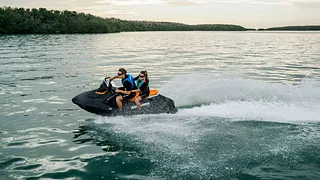- News
Unveiling the evolution - A deep dive into the history and development of personal watercraft (PWCs)

The development of jet skis can be traced back to the 1960s when aeronautical engineer Clayton Jacobson II sketched his “motorcycle for the water”, which looked like a sort of powered jet ski. During the years Jacobson spent his time developing a real jet ski concept and the prototype was up and running by 1965. It was a small watercraft powered by jet propulsion - and that patent he later sold to Kawasaki Motors Corp, which developed the first commercially available PWC in 1972, known as the Kawasaki Jet Ski.
While Kawasaki may have been the first company to commercialize PWCs, several other popular jet ski manufacturers have emerged over the years - Sea-Doo and Yamaha are well-known manufacturers of personal watercraft.
Sea-Doo is a brand owned by the Canadian company Bombardier Recreational Products (BRP). Bombardier introduced its first personal watercraft in 1968, called the Bombardier Sea-Doo. In 1988 the Sea-Doo was re-introduced as its own brand under Bombardier and by 1995, annual sales for the Sea-Doo reached over 100,000 units and by 1997 the company had $212 million in sales, recapturing over half of the PWC market. Finally, in 2016. they had a 45.8% share of the PWC market.
Sea-Doo has a rich lineup that includes a range of models, from the budget-friendly Spark to the high-performance RXP-X and their models are recognized thanks to its advanced technologies and innovations.
Yamaha introduced the WaveRunner 500 (Marine Jet 500T) in 1986 as their first PWC. Since then, Yamaha become one the most popular brands in the industry with its wide range of models - from the EX series to the high-performance FX series - made for riders of all skill levels.

From the beginning to present
PWCs were initially primarily used for rescue operations and other professional purposes, but they soon became recognized as a new type of watercraft as they gained popularity among recreational users. Additionally, jet skiing began to gain popularity worldwide and quickly became a favorite, particularly in warm coastal regions.

With the establishment of governing bodies like the International Jet Sports Boating Association (IJSBA), the popularity of jet skiing continued to rise throughout the 1980s and 1990s and it became a recognized sport. Step by step, jet ski competitions began to be organized and some of the most popular are The Pro Watercross Tour and The World Finals.
Pro Watercross Tour is a high-energy competition for jet ski riders from all over the world to test their agility and skill. It includes slalom, freestyle, and endurance racing competitions among others.

One of the largest jet ski competitions in the world, the World Finals is held annually in Lake Havasu City, Arizona, attracting thousands of competitors and spectators.
With the development of technology and designs that make the sport safer, jet skiing has continued to evolve. And today, jet skis come in a variety of sizes and designs, ranging from small, easy-to-maneuver models to larger, more powerful ones made for racing and high-speed cruising.
You may also like
OtoTrak Powers the Mille Iles European Jetraid Cup

Discover some of the most famous competitions in the world of jet skis


